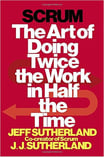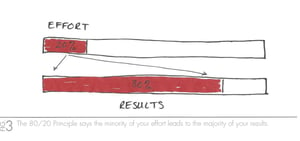 In my experience a lot of business leadership teams invest an exorbitant amount of time discussing and making changes on the wheels of the vehicle the company is driving, while very little time is invested in the direction for the vehicle the ultimate destination.
In my experience a lot of business leadership teams invest an exorbitant amount of time discussing and making changes on the wheels of the vehicle the company is driving, while very little time is invested in the direction for the vehicle the ultimate destination.
It seems fixing a tire, determining whether the wheel should be mag or regular chrome covers, the air pressure, who should fix said tire, etc., etc., consumes most of the energy the organization spends in getting somewhere.
Doesn’t it make sense to know where you are going first? Once you know where you are going you can determine what’s the best tire based on the terrain, miles you’re driving, speed required, weather you’ll encounter, and perhaps based on all this who exactly is the best person to drive it?
Tires on a vehicle are just a metaphor here, or a figurative representation of how companies invest far too much time in the lower right hand quadrant of the Eisenhower Matrix.
So much time is wasted on tactical work when all of this could be avoided simply by determining your destination. The determination of your destination provides the insight in to what tactical work requires prioritization.
In Scaling Up Verne Harnish notes Decisions Equal Success. There are Four Decisions, in growing your business, that you must get right or risk leaving significant revenues, profits, and time on the table. These four decisions: People, Strategy, Execution, and Cash.
Change or Die is what Jeff Sutherland advises the company’s he consults on  Scrum: The Art of Doing Twice the Work in Half the Time. Any company that fails to recognize the need to continually change and adapt to market dynamics risks extinction.
Scrum: The Art of Doing Twice the Work in Half the Time. Any company that fails to recognize the need to continually change and adapt to market dynamics risks extinction.
Preparing to Win
“It's not the will to win, but the will to prepare to win that makes the difference.” - Bear Bryant, Alabama College Football Hall of Fame Coach
We discussed the ability to predict as one of the two most important attributes of Leadership – Are You Chasing Waterfalls? From 1984 – 1996 long before I realized the value of forecasting, I worked as general manager for two radio stations in Wausau, Wisconsin. In 1991 I spent a significant amount of time preparing a projection and cash flow forecast for the business owner I worked for. It projected revenue and cash for the coming year. The owner came to our meeting expecting a certain level of profit. The budget and forecast I’d prepared wouldn’t accommodate his number. His response simply was to pretend the budget and forecast didn’t matter. He’d never used these tools in his business. The application confused and perhaps even frightened him. He’d never had anyone prepare and plan ahead like this.
The meeting was an epiphany for me. When I realized, albeit successfully, he was flying by the seat of his pants, I knew it was time for me to strike out on my own. In less than a year I’d moved to become owner of a new radio station in the same city. Using these same tools I’d presented to him, in just two years we’d supplanted his station as the #2 revenue producer in the market and we’re exceeding the profit I’d projected.
None of the companies I work with fail to invest sufficient time to develop their annual plan. Without exception our customers invest a minimum of 2 days on their Annual Plan.
When it comes to Quarterly Planning the story is often far different. Often 4 hours is the maximum many will apportion for this critical planning and strategizing meeting.
Why? Why, when we invest so much time preparing for the year do we fail to take sufficient time to review, analyze and even congratulate ourselves on our progress? Is it because in the midst of the process we become too tactician oriented? It’s as if once our sleeves are rolled up we refuse to take a break. Sure we analyze the numbers, measure progress on our #1 Thing and then plan the next quarter. Isn’t this a good time to assess which of our Four Decisions is most critical? Isn’t this a perfect time to focus attention and make additional progress on our One Thing?
It’s almost as if we’re so focused on the outcome we fail to take a breath long enough to not only enjoy our success but to assess what we need to achieve to reach our vision.
Let’s not confuse time invested with results either. One of my customers frequently invests 2 to 2.5 days on a quarterly meeting. Their investment more frequently have failed to achieve maximum return on their quarterly planning sessions. Why? For the same reason the customers who invest only 4 hours in this process fail to achieve more. Time dedicated to long term planning and strategizing is limited. Worse when we have achieved results they’ve failed to apply or implement what they’ve created within their business.
In the past year these meetings have delivered their Core Purpose, and BHAG. We began work on a Strategy Statement, something my other customers have discovered brings significant value in determining not only their destination for their company, but specific clarity on their objective, scope and advantage against their competition.
Four Purposes for Quarterly Planning
The purpose of a Quarterly Planning Session is fourfold:
1) To review your results from the previous quarter;
2) To check in on your company’s cultural health and team performance;
3) To participate in Executive Education to keep you sharp and new ideas flowing to grow the business;
4) To plan your next successful quarter. If we achieve these four objectives today, it will be a very successful day spent together
Download these Four Purposes of Quarterly Planning to remind you of what your benchmarks are for your business. The portion too frequently forgotten, left out, or simply given no or little attention is #3.
80-20 Rule
 Monday morning I met with a leadership team member of one of my customers. He’s nearing retirement yet still putting in a 60+ work week often 7 days a week. We discussed his priorities noting that one customer in his company’s portfolio contributes 42% of their volume. Another customer is a consistent significant contributor. He’s been working on making these two customers his priority. Yet he continually gets distracted by the company adding new products and customers who clearly aren’t priorities but require a time investment.
Monday morning I met with a leadership team member of one of my customers. He’s nearing retirement yet still putting in a 60+ work week often 7 days a week. We discussed his priorities noting that one customer in his company’s portfolio contributes 42% of their volume. Another customer is a consistent significant contributor. He’s been working on making these two customers his priority. Yet he continually gets distracted by the company adding new products and customers who clearly aren’t priorities but require a time investment.
We discussed how he can remain focused on his 80% to drive his and the company’s numbers. My recommendations included completing a time study of where he is currently investing his day. Reviewing his should help him determine how he can drive more of his time dedicated to these two customers to help them perform even better. As he apportions more of his time to these customers and reaches greater success his results alone will convince his leadership that dividing his attention on other products or priorities is a losing proposition.
What he needs to do is show how focusing on his One Thing is best not only for him but for the company.
What's your One Thing? Are you and your team focused on this for the year and this coming quarter?
Are you changing or dying?
The Time Question: Teams or Individuals
In Scrum: The Art of Doing Twice the Work in Half the Time by Jeff Sutherland, Sutherland reveals a Harvard Business School study on students who scored high in a teacher’s class. The study focused on the time each student invested to achieve their high grades. What might surprise you is not how much time they invested, but how when a similar study is conducted on teams the vast difference in team performance against time invested. We’ll answer the question: Which is more important individual or team performance. It may change your mind on the value of A players. That’s next blog.






.jpeg?width=150&height=135&name=Hand%20with%20marker%20writing%20the%20question%20Whats%20Next_%20(1).jpeg)

